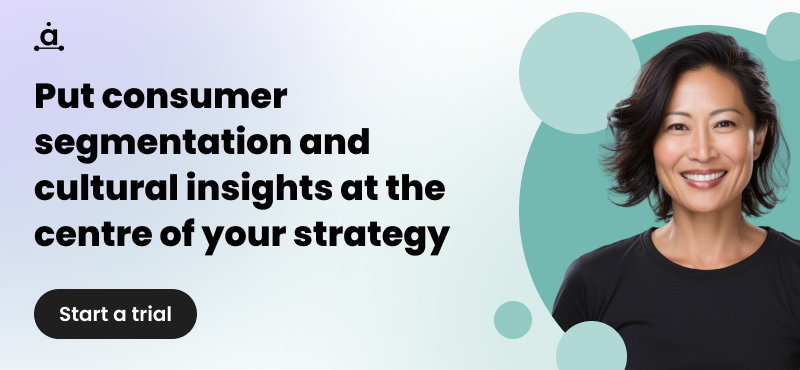Target market vs. target audience: key differences and how to find yours
Every business and marketing strategy needs to target a specific group of people to ensure success. This is the only way to make sure that you’re creating products and developing messaging that will resonate with your ideal customers. That’s where terms like “target market” and “target audience” come into play.
You might think "target market" and "target audience" are the same thing; two different ways of describing people your brand wants to reach. But actually, there are some key differences, and in terms of your marketing efforts, they matter.
Let's break down the differences between target market and target audience and how they influence your marketing strategy.
What is a target market?
Your target market is the broad group of people you believe will benefit from and purchase your products or services. This group typically shares demographic characteristics such as age, gender, ethnicity, occupation, income, and location.
For example, let’s say you’ve developed a product that helps men with early hair loss. In this case, you might be targeting men between the ages of 25-34 who live in America.
The target market would look like this:

Want to find your own target market? Run your own Audiense report today in just three clicks.
What is a target audience?
Your target audience, on the other hand, is a narrower term referring to a specific section of your target market. This is the group of people you want to target for a specific advertising activity, marketing campaign, or promotion effort.
The target audience would look like this:


The “Conservative Patriots” is a subsection of the greater target market audience of men who are experiencing hair loss.
So let’s say you were building an ad campaign to target this subsegment. You could use the Audiense platform to surface insights on how to target this audience specifically.
What you might discover is that these “Conservative Patriots” get their news from Fast Company and TechCrunch, indicating where you should place your ad if you want this audience to see it.

TechCrunch and Fast Company are huge publications and therefore could quickly eat up a big portion of your ad budget so using Audiense again you could surface publications like the Gizmodo or Engadget blog. These are more budget friendly options but because they are highly popular with your target audience, they are a good option for buying ad space.

This is just one simple example but it demonstrates that when you’re making certain marketing decisions like where to place your ad spend, you are referring to insights related to your specific target audience.
P.S. - With Audiense, you can easily identify the media and content preferences of your target audience. This valuable data empowers you to make strategic decisions about which channels, publications, and media sources to target, ensuring you achieve the right coverage.
Run your own report and find out who your target audience really is.
Why your target market matters
Your target market will essentially influence all your general marketing and business decisions. For example, you may develop products based on your findings about what your target market wants or needs:

For instance, you might discover that your target market is looking for a product that is fast and efficient. They don’t want to wait for results so they are willing to pay more money for a product that can solve their problem quickly. So your target market of men aged 25-34 might be looking for a hair loss solution that can demonstrate results right away.
Other aspects of your business such as sales processes, pricing, packaging, etc. all depend on the preferences of your target market.
That means your target market decides whether you sell your products in-store or digitally or both. It decides whether you use biodegradable packaging and spend a little more or a cost-effective plastic alternative.
Why your target audience matters
Your target audience typically influences your advertising decisions. For example, you may choose channels, platforms, influencers, and publications depending on your target audience’s preferences, habits, and personality traits. You’ll also craft messaging and offers that can appeal to this target audience.
That means your target audience decides whether you advertise on TV or on social media, on Facebook or on Instagram, on The New York Times or on TechCrunch, and so on. It decides whether you use images or videos, thought leadership articles or reviews, influencer content or paid ads, etc.
Audiense provides you with audience insights that give you a detailed look at your audience’s online habits, buying mindset, personality, interests, media affinity, and more. This allows you to get even more specific with understanding your target audience and use this information to inform your campaigns.
So for instance, the personality of your target audience may be adventurous, expressive, and excitable. This could shape your campaign message in a way that connects with them — something like “stop worrying about things like hair loss, so you can worry about the more important things in life, like where to take your next adventure”, and in the campaign, it can show a man with a full head of hair ziplining in the jungle (you get the idea).

Similarly, you can get really specific with your campaign targeting based on your audience’s online habits. So in addition to creating the type of content they like, you can promote it through the social media platforms they frequent, such as LinkedIn.

You can also decide when to publish your campaign based on their most active hours.

Learn what to post, when to post it and where with Audiense insights.
What are the key differences between target market and target audience?
Although the two terms are interrelated, they are not the same. Here’s a quick overview of the differences and similarities to help you remember the difference between the two.
- Your target market refers to a broader group of people you want to reach whereas your target audience is a subset of that broader group.
- Your target market influences your business and marketing decisions in general, whereas your target audience specifically plays a role in your campaign decisions.
Take a look at the characteristics you use to define each:

Click here to download this table for future reference.
So your target market may be “Tech Dad’s living in the U.K,” whereas your target audience may be “Creative Digital Service specialists living in the U.K and following Steve Case.”
.png?width=1999&height=1053&name=Image%20(34).png)
The Audiense platform lets you narrow down on niched influences under the “Influencers & Brands'' tab. You can use different filters to find the micro-influencers that are more realistic to reach and highly relevant to your target audience.
Discover the micro-influencers who resonate with your target audience.
Steps to help you define your target market and target audience:
Here are some easy steps to follow when trying to identify your target market and target audience.
Target Market
Remember, your target market is the broader group of customers you’d like to reach with your product or service.
Step 1, answer the following questions:
a: What problem does your product or service solve for your customers? Ex. “We created a line of frozen Vegan Empanadas for those who love Empanadas but couldn’t find a meatless alternative”
b: What sets your product apart from other competitors or alternatives? Ex. “Our Empanadas are also low calorie”
c: Who do you envision buying your product - how old are they, what is their gender, where do they live? Ex. “We envision that our product will mostly be purchased by Vegan women aged 25-45 who live in the USA.”
Step 2: Use that info to build an Audiense report to collect this Target Market (your broader audience):

Choose how many different segments you want this audience to be broken down into (these smaller segments will be different target audiences):

Here’s what the result looks like - that’s your entire target market:

Target Audience
Remember, this is a more specific subset from within the target market, that you are going to try to engage with and build a marketing campaign around. This is where you identify more detailed demographics, interests, and personality traits.
Step 3: Pick the largest or most promising segment from within your target market, like for example this “Culinary Lifestyle” segment:

Step 4: Define this as your target audience, and create a specific customer profile on them that your entire marketing team can refer back to, including insights on their top media channels, social channels, influencers, and content:



Now you can use this data to build a campaign specific to your target audience. For example, based on these insights you could create a campaign where you team up with one of their top influencers Isa Chandra a Vega Cookbook author, to create a Vegan dip for the Empanadas that you post to Pinterest (their top social channel), and promote on the Food Network (their top media channel).
Find your target market and target audience now!
Why does it matter?
If you follow these steps above, and apply the insights to your next campaign, you should see an increase in:
✅ ROI: when you identify where best to place your ad spend, you stop wasting it on platforms your audience doesn’t use
✅ Engagement/conversions: when you know exactly what copy and creative will grab your audience’s attention, you’ll see an uptick in engagement and people are going to convert
✅ Customer loyalty: building a brand that is known to never miss the mark, and always be in touch with its target audience’s needs and values, will always have loyal customers
By knowing the difference and taking the time to define your target market and target audience, you ensure that every strategy you build is coming from the right place.
This ensures that your marketing budget is spent where it needs to be spent, your campaigns resonate, and all your customers feel seen.
Audiense insights gives you real data about who your target market and target audience is, and what drives them.
Ready to find your audience? Run an Audiense report now and understand your consumers like never before.
FAQ
Why is audience targeting important? Audience targeting is important because it allows you as a brand to focus on a specific section of your greater audience and create content that is personalized to them. Ultimately, it leads to better campaigns because they resonate with the personality, needs and interests of your specific target audience.
Why is it important to identify your target audience? It is important to identify your target audience so that you can tailor your marketing efforts to them, increasing campaign efficiency, performance, and ROI.
What’s the difference between a target market and a target audience? Your target market refers to a broader group of people you want to reach whereas your target audience is a subset of that broader group. Your target market influences your business and marketing decisions in general, whereas your target audience specifically plays a role in your campaign decisions.
What are some examples of a target market? Some examples of a target market are: Moms Age 25-34 who live in the USA, Tech Millennials from China.
What is an example of a target audience? An example of a target audience would be “DIY Moms who love Carrie Underwood” (a subsegment of the target market of Moms Age 25-34 who live in the USA).
How do I identify my target market? Follow these steps to identify your target market.
What are two types of target market activities? Product development and creating a pricing strategy are two types of activities you perform based on the insights you surface on your target market.
What are the benefits of target market segmentation? Increased ROI, audience engagement and customer loyalty are the main benefits of target market segmentation.
What is a target market strategy? A target market strategy is essentially a business plan that is created that focuses on a specific group of consumers that you define by using characteristics like demographics, age, income, and location.





.png?width=60&name=image%20(62).png)
